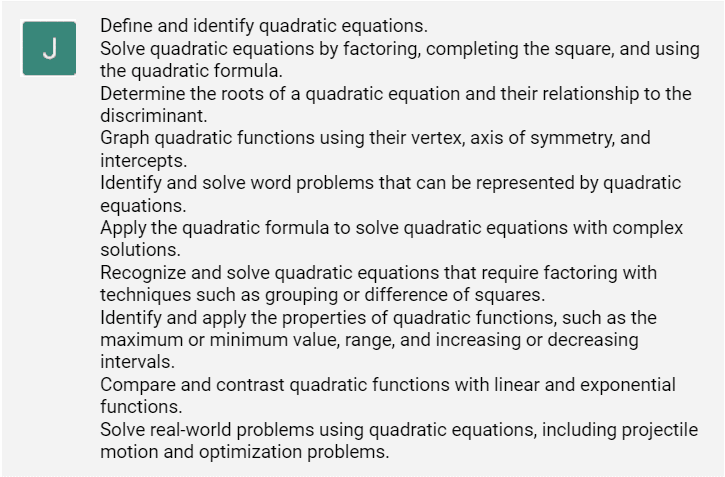Supporting Study Skills with A.I. Tools
A key opportunity for teaching and learning with A.I. tools is the ability to support students’ study skills. A.I. tools can be used to both generate study materials and engage in learning conversations with the student, acting as a personal study buddy.
Generating Study Materials
The quick response-time of A.I. tools support student learning by allowing them to generate study materials in seconds!
1. Study Guides for Conceptual Understanding
A.I. tools can be used to generate study guides about various concepts covered in lesson or course.
2. Study Guides that Map to Learning Objectives
A.I. tools can generate study materials that align with course learning objectives. Simply copy and paste course objectives directly into the A.I.
3. Vocabulary Review
A.I. tools can generate tables with key terms and definitions and flashcards for reviewing core vocabulary and key concepts.
- View example prompt and output: Key terms and definitions
- View example prompt and output: Flashcards
4. Concept Maps
A.I. tools can support students’ development of concept maps by generating the central idea, main concepts, and subconcepts. Students can then draw out and make connections between concepts.
5. Practice Assessments
A.I. tools can generate practice assessments in seconds!
6. Case Studies
A.I. tools can create authentic problems such as case studies for a given discipline and issue.
7. Application Problems
A.I. tools can create application problems, or a mix of different question types.
Welcoming A.I. as Study Buddy
A key feature of A.I. tools like ChatGPT is their ability to engage in conversations with the user and to break down complex concepts. This makes them a great on-call study buddy to help using the strategies below:
1. Concept Explainers
Students can prompt the A.I. tool to explain a concept according to their desired level of understanding (e.g. the appropriate audience for the explanation).
2. Process Explainers
A.I. tools can be extremely helpful when students’ need help understanding how to perform a procedure.
3. Worked Examples
A.I. tools can provide worked examples of a user given, or A.I. generated problem.
4. Learning Conversations with the A.I.
What makes A.I. tools different from other study tools is their ability to engage with the student in learning conversations.
How to engage in learning conversations:
- Copy and paste course objectives or exam topics into the A.I. prompt.

- Prompt the A.I to generate a short quiz aligned to course objectives.

- Prompt the A.I. for feedback on a solution.

- Prompt the A.I. to help solve a difficult problem.

- Prompt the A.I. to generate additional questions for practice.

- Prompt the A.I. to show a different method for solving the same problem.

- Prompt the A.I. to explain how to solve problems using external tools.

- Prompt the A.I. to suggest areas of focus for future studying, based on your performance so far
